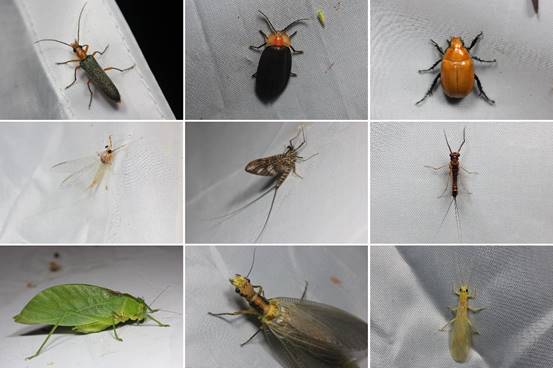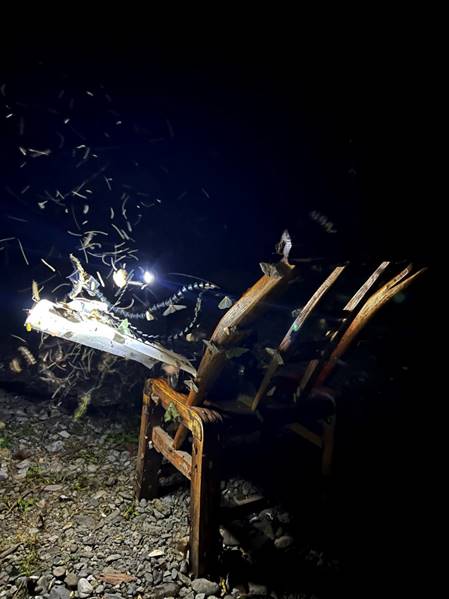Nighttime Flutters: Shennongjia Forest Alive with Insects Taking Flight
Updated:2023-06-25 Source:Shennongjia National Park
Located at the eastern end of the Qinling-Dabashan Mountains, Shennongjia is said to have derived its name from the legendary Yan Emperor, who used to construct ladders with trees to taste various herbs and build altars with wood to ride cranes and ascend to the heavens. This extraordinary piece of land fosters a diversity of wildlife, serving as a vital component of worldwide biodiversity conservation initiatives.
Led by Professor Wei Cong from the Northwest Agriculture and Forestry University, the first joint expedition on insects and spiders of the Shennongjia National Park commenced on June 5, 2023. The expedition team, consisting of over 50 experts, scholars, and graduate students from universities and research institutes across the country, engaged in a one-month field investigation and specimen collection process.
Insect and arachnid species are abundant in their diversity but often go unnoticed due to their small size and concealed habitats. Nevertheless, they hold significant ecological importance in the ecosystem. In terms of their activity patterns, insects can be categorized into diurnal and nocturnal species. The nocturnal species emerge only at night, making it challenging for the expedition team to detect and capture them. As dusk falls, the six-legged insects that remain elusive during the day come alive. The team of scientists and researchers set up high-pressure mercury lamps in strategic spots during the day and wait patiently for their arrival (Figure 1).
 Figure 1: Nocturnal Insect Attraction
Figure 1: Nocturnal Insect AttractionA diverse array of nocturnal insects were attracted by the lamp. They joined the specially-designed stage for an evening dance under the light and created a lively spectacle. Some insects exuded excitement and some were really elegant, continuously tracing beautiful arcs around the lights, while others stood as mere spectators on the stage, watching the performances of their fellows. There were also those who acted like drunken revelers swaying wildly or careening down mischievously.
Among these colorful nocturnal insects, the small-sized leafhoppers from the order Hemiptera were numerous and full of enthusiasm. Once there was a glimmer of light, they couldn't wait to land on it, hopping and darting around, moving closer to the brightest spot, aiming to claim the center. But after a while, they flew back and forth, colliding with each other. If you take a closer look at the leafhoppers perched in the center of the lamp curtain, you'll notice some noble spirits in plain attire, while others were showcasing the latest fashion trends in their extravagant costumes (Figure 2).
 Figure 2: Diverse and Colorful Leafhoppers
Figure 2: Diverse and Colorful LeafhoppersWe also captured some beetles from the Coleoptera order. With dazzling metallic sheen and sturdy elytra protecting their vulnerable abdomens, these beetles are quite eye-catching (Figure 3). The diversity of beetle species is unparalleled. Besides large Lucanidae armed with powerful mandibles, measuring more than ten centimeters in length, we also observed tiny Curculionidae adorned with elongated snouts, Carabidae (also known as farting beetles) capable of ejecting hot gases to repel enemies from a distance, and fireflies that twinkled and conveyed sweet messages through their luminescent posteriors. Each species was unique and possessed remarkable wisdom and abilities in the wild. They seemed like forest knights who could effortlessly surpass any challenge and roam the world at will.
The longhorned grasshoppers and crickets from the order Orthoptera are different from other nocturnal insects. They only softly performed chirping and singing amidst the dense night (Figure 3). The Acanthacorydalis from the order Megaloptera and the stoneflies from the order Plecoptera, whose larvae live in the water, were also attracted by the light. As soon as they emerged, they constantly flitted about in the rare brightness (Figure 3).
Among all the insects we captured, mayflies were the most carefree. They remained composed and unbothered as they made their way to the high-pressure mercury lamps-an illuminated stage for them (Figure 3). In the ancient Chinese poetry from the Book of Songs, mayflies were praised for their beauty, but mourned for their short life. The poet could only marvel at the beauty of mayflies, unaware of the joy they found in their fleeting existence.
 Figure 3: Various insects from different orders, perhaps oblivious to each other's existence
Figure 3: Various insects from different orders, perhaps oblivious to each other's existenceThe moths from the Lepidoptera order (Figure 4) epitomize a yearning for light. Unlike butterflies, they don't flutter in daylight but instead eagerly gravitate towards any glimmer, showcasing their own exquisite beauty. While people often mock moths for their self-destructive behavior of flying towards flames, the beauty of moths has been revered since ancient times. In the Tang Dynasty, the Magnificent Concubine Yang was the first to draw her eyebrows in the likeness of moth antennae, which since then were known as "moth eyebrows." Perhaps it was the brows, with their distinctive shape, that immortalized Concubine Yang's beauty, inspiring poets like Bai Juyi to vividly depict her allure in his masterpiece Everlasting Regret, a classic romantic tragedy in Chinese literature.
 Figure 4: Moths
Figure 4: MothsVenturing into the dark of the valleys and mountains in Shennongjia to capture insects at night was such an exhilarating experience that it sparked our boundless imagination. Just before dawn, as the glow from our high-pressure mercury lamp faded, the insects swiftly escaped our trap but were quickly enticed by the shimmering camera on the nearby bamboo chair. This camera becomes another tool for attracting insects (Figure 5).
The scene evoked a poetic sentiment in my team member Jiali, who was still observing the insects. She improvised and recited a poem:
In that nocturnal realm, my soul took flight,
As the insects shimmered in the moon's gentle light.
A dance of enchantment, a twilight's embrace,
I was mesmerized, lost in this magical space.
We were all lost in the poetic dim light of dawn and the enchanting night of venturing to the insect world came to an end before we knew it.
 Figure 5: A chair for posing tools to attracting moths and the insects it captured
Figure 5: A chair for posing tools to attracting moths and the insects it captured By Zhang Wenzhe, Northwest Agriculture & Forestry University
Copyright Shennongjia National Park
Address:36 Chulin Road, Muyu Town, Shennongjia Forestry District, Hubei Province 鄂ICP备18005077号-3
Address:36 Chulin Road, Muyu Town, Shennongjia Forestry District, Hubei Province 鄂ICP备18005077号-3
Email:2673990569@qq.com
Phone:0719-3453368
Phone:0719-3453368


TOP

